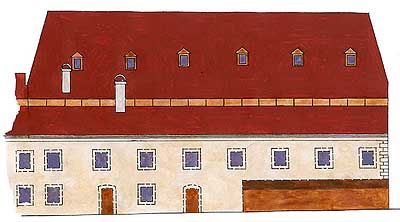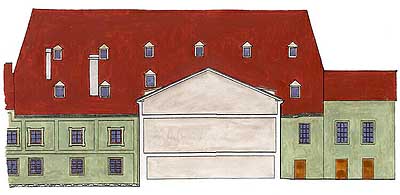Kájovská No. 56
Description of the Building:
A complex of buildings with an average coutyard. Along the street
there is a one-storey house, which is of a little value because of
its false front. It follows with a one-storey right court wing,
with a lower second floor. The front is articulated with lisenas
and the windows with stucco moulding. On the ground floor of this
wing are sections vaulted with barrel vaults with and without
lunettes, on the eastern side there is a garage with a flat
ceiling. The rear elevation wall along the river became a part of
the back building together with its articulation. The inner
construction is from wood, there are two storeys. On the right is
an extention above the mill-race, at the back there is an extention
with barrel-vaults on the ground floor and with flat ceilings on
the upper floor. On the left hand side in the yard there is a
garage.
Architectural and Historical Development:
The complex is probably of Gothic origin, because a mill below the
church is mentioned even in 1347. The mill seems to have been
included in the fortification system of the town, because the land
parcel is situated in the moat. The thick front wall must have had
a defending character. The buildings served as a mill ( temporary
paper mill ) to the recent time. During the reconstruction in 1597,
mentioned in the books, the rear building was probably added and
adjusted according to the needs of production. This is why the side
extentions towards the church and above the mill-race were built.
The southern wing, abutting on the town wall as well as the main
building, originated during the Classical reconstruction in 1737.
The fronts were reconstructed additionaly. The building along the
street was built in an adjusted street line in 1881, the left court
wing originates from the reconstruction of an older building.
Development of facade:
During the years 1613 - 1614 a new paper-mill building was built on
the place of an older original mill building. Only a plastic head
ledge, the corner rustic-work at different length and holes framing
with a rough-smoothen basic surface articulated a quite simple
facade.
Only a fragmental scale of white-and-grey-coloured articulation was preserved from the Baroque period. The paper-mill was extended to the east in the Baroque-and-Classicism period, and the whole building was newly plastered.
The facade surface was articulated at the 1st-floor level, a grey-and-white-coloured scheme in contrast o f smooth framed surfaces and a rough basic surface was used. The illusion band rustic-work articulated the ground floor.
The building have been covered in all-surface green-coloured coats of paint since the early 19th century, apart from one ochre-coloured paint. At the turn of 19th and 20th century a two-floor wing was built above the mill-race.
Significant Architectural Features:
Southern and northern front with articulation and all the
details.
History of the House Residents:
The mill was originally kept by the municipality, according to the
list of town properties from the end of the 14th century. Some time
in the 15th century it must have been sold to a private owner,
because in 1518 a miller Šebestián sold it to Kašpar from Pecka.
Kašpar sold the mill in 1521 to a miller from Prachatice, Jan. Jan
sold it quickly to Kříž, a miller from Strunkovice. The mill was
bought from him in 1545 by "Vít Kašpara, the miller´s son-in-law,
and Fencl, his brother-in-law".
Sometime in the mid 16th century the mill was changed, with the approval of the magistrate, into a paper mill. In 1572 the town council sold the paper mill with all the machinery for producing paper, furniture, and beddings to a paper miller Wolf Waldera for the total price of 400 three scores of Meissen groschen. The transaction was done with the approval and share of Kateřina Valentová "at the hammer-mill", her son Vít and her son-in-law Wolf Holnhammer. In 1579 the municipality bought the paper mill back because of debts which had not been paid by the owners, who changed there very quickly. The building was so devastated, that the municipality had to pay a huge amount of money to resume production. There was a significant building action held by the municipality in the years 1613 - 1614, when a new building was built called the new paper mill. The municipality did not invest much in the paper mill during the 17th and 18th centuries, just rented it and maintained it in good condition, which was rather expensive and problematic. This is why the municipality sold the paper mill to a businessman and later a noble landowner Jan Jiří Pachner. The Pachners owned the paper mill all during the 19th century.
Present Use:
Newsstand U Mrázků, Textile-footwear Jiří, mobile phones








